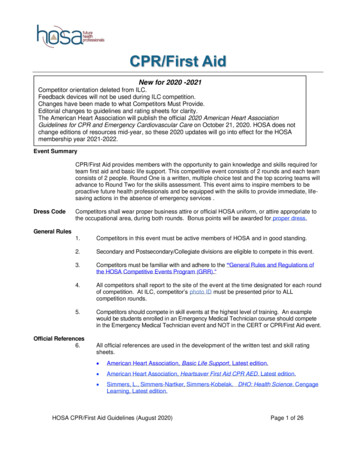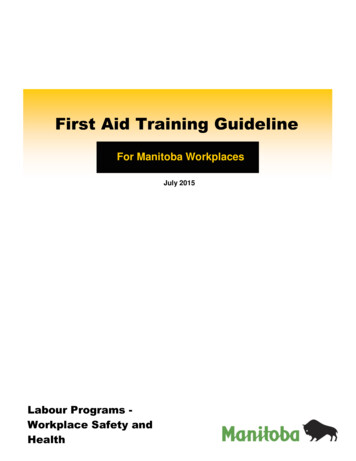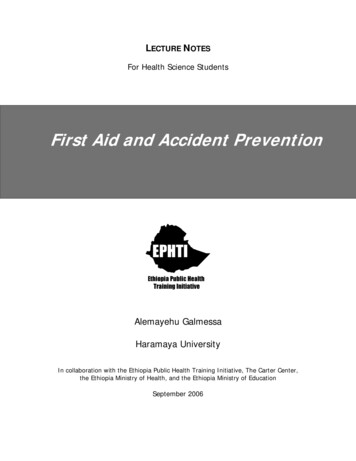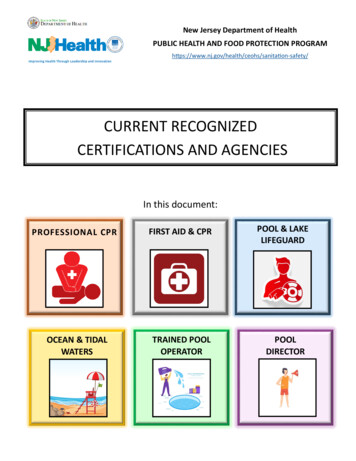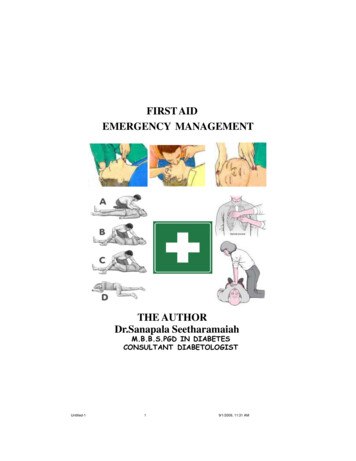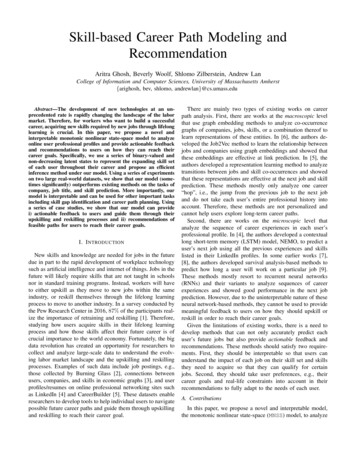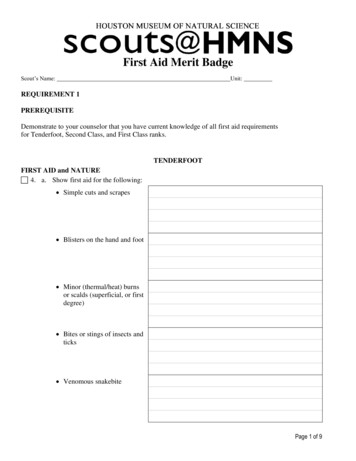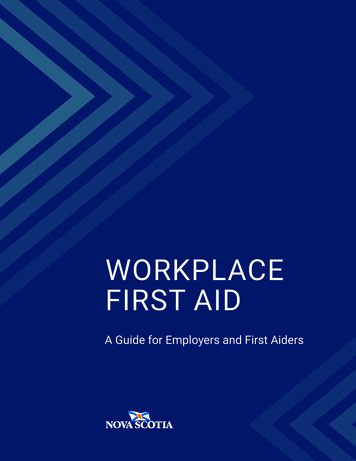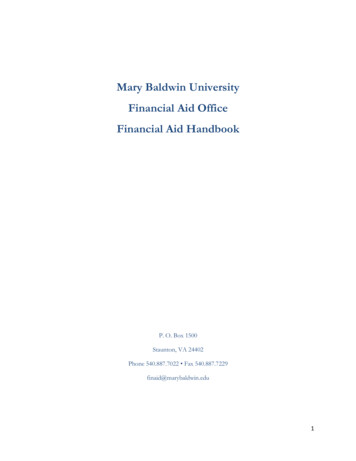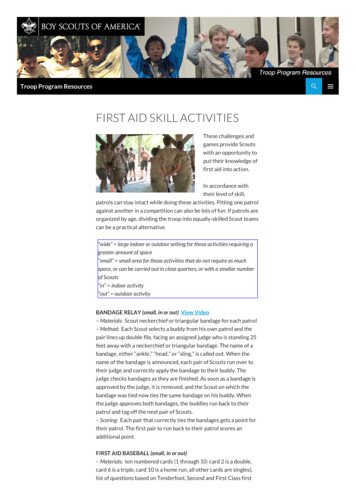
Transcription
Troop Program Resources FIRST AID SKILL ACTIVITIESThese challenges andgames provide Scoutswith an opportunity toput their knowledge offirst aid into action.In accordance withtheir level of skill,patrols can stay intact while doing these activities. Pitting one patrolagainst another in a competition can also be lots of fun. If patrols areorganized by age, dividing the troop into equally-skilled Scout teamscan be a practical alternative.“wide” large indoor or outdoor setting for those activities requiring agreater amount of space“small” small area for those activities that do not require as muchspace, or can be carried out in close quarters, or with a smaller numberof Scouts“in” indoor activity“out” outdoor activityBANDAGE RELAY (small, in or out) View Video– Materials: Scout neckerchief or triangular bandage for each patrol– Method: Each Scout selects a buddy from his own patrol and thepair lines up double file, facing an assigned judge who is standing 25feet away with a neckerchief or triangular bandage. The name of abandage, either “ankle,” “head,” or “sling,” is called out. When thename of the bandage is announced, each pair of Scouts run over totheir judge and correctly apply the bandage to their buddy. Thejudge checks bandages as they are finished. As soon as a bandage isapproved by the judge, it is removed, and the Scout on which thebandage was tied now ties the same bandage on his buddy. Whenthe judge approves both bandages, the buddies run back to theirpatrol and tag off the next pair of Scouts.– Scoring: Each pair that correctly ties the bandages gets a point fortheir patrol. The first pair to run back to their patrol scores anadditional point.FIRST AID BASEBALL (small, in or out)– Materials: ten numbered cards (1 through 10: card 2 is a double,card 6 is a triple, card 10 is a home run, all other cards are singles),list of questions based on Tenderfoot, Second and First Class first
aid requirements– Method: A miniature baseball diamond is marked out on the floor.The first patrol lines up behind home plate. The “umpire” (gameleader) holds the cards in his hands. In turn, each Scout in that patroltries to answer a question given to him by the umpire. If the Scoutgives the correct answer, he draws a card. He scores whatever hit isindicated on the card and becomes a base runner as in regularbaseball. If he does not answer the question correctly, he is out.After three outs, the next patrol comes to bat.– Scoring: The patrol with the most runs after two innings is thewinner.FIRST AID CARRY RELAY (wide, in or out) View Video– Method: Patrols line up in relay fashion facing a single turnaroundpost located 15 feet away. Two Scouts from each patrol carry thefirst “injured Scout” using Two-Person Carry around the turnaroundpost and back to the starting line. Next two Scouts carry the second“injured Scout” using the Four-Handed Seat Carry around theturnaround post and back to the starting line. Next Scout carries thethird “injured Scout” using a One-Person Carry around theturnaround post and back to the starting line. If at any time an“injured Scout” touches the ground, the Scouts carrying this “injuredScout” must stop, reform their carry and continue.– Scoring: The first patrol making a complete circuit with the three“injured Scouts” scores wins.FIRST AID SCENARIOS (small, in or out)– Preparation: The following scenarios can be printed out anddistributed as a point of reference: Scenario A: A Scout zigzagging on a bicycle is hit by a car. Hereceives a cut on his left forearm that severs an artery. He alsosustains a simple fracture of his right leg. Scenario B: A driver is speeding along a country road when one ofhis tires blows out. The car crashes into a pole. The driver receives asimple fracture of the right forearm and a gash on his right shoulder,causing arterial bleeding. Scenario C: While on a hike, a Scout patrol finds an electricalrepairman lying at the bottom of a transformer pole. He is notbreathing and has burns on both hands. Scenario D: While swimming in a country pond, one Scout jumpsfrom a rock ledge and does not come back up to the surface. Theother Scouts notice he is gone, jump in, and pull him out. He is notbreathing and has a gash on his forehead that is bleeding profusely. Scenario E: A Scout is riding his bicycle when a dog bites him onthe right ankle. The Scout swerves to get away, and falls heavily onthe road. He lacerates a large area of his left elbow into which dirtand sand are ground. His left wrist is swollen and painful. Scenario F: A woman is pinned under a pickup truck that hasoverturned at the side of the road. When she is released, it is foundthat she has a cut over her right eye and is spurting blood. Her rightankle is very painful and swelling rapidly. Scenario G: On an extremely hot day, several Scouts are sitting ona fence in front of their high school, watching a parade. One of theScouts falls to the ground. His face is hot, dry, and flushed, and hispulse is exceptionally rapid. His left ear is torn and bleedingprofusely.
Scenario H: On a very cold day, an unconscious man is found lyingbehind a train shed. It is evident that he slipped on the railway trackand struck his head. There is a gash running five inches from thefront to the back of his head and it is bleeding profusely. The skin onhis face is very cold, and his ears are pale.– Method: Depending on how much time is to be allotted for theactivity, one or two scenarios are assigned to each patrol. After twominutes of deliberation, in turn, each patrol narrates a course ofaction detailing the correct approach to administering appropriatefirst aid.– Scoring: As determined by a panel of judges, depending upon thedetails and accuracy of their presentation, a patrol can score up tofour points pertaining to their scenario.ICE ACCIDENT (wide, in or out)– Materials: for each patrol, a 10 to 15-foot rope, a Scout stave orbroomstick handle, and a blanket– Method: Casually arrange the equipment in a corner of the room sothat it’s ready for use, but don’t draw attention to it. Have eachpatrol place a Scout “victim” in a prone position at the opposite endof the room. Announce that these victims have broken through theice and that it is up to each patrol to rescue its victim and to renderfirst aid.Note the following: Whether or not ropes and staves are noticed and used Whether or not the victim is warmed by the blanket and treatedfor shock Whether or not the need to administer CPR is ascertained Whether or not medical help is summoned– Scoring: The patrol with the best performance and time wins .KIM’S GAME: FIRST AID (small, in or out)– Materials: blanket or tarp, collection of ten or more first-aidobjects such as: gauze pads, bandages, splints, adhesive tape,absorbent cotton, scissors, tweezers, sunburn ointment, antibioticointment, rubber gloves, thermometer, etc., and ten or more objectsnot used in first aid such as: a ball, paper clip, merit badge pamphlet(not first aid), pencil, penny, photo, shoe, glove, hand ax, toothpaste,etc.– Method: All objects are spread on the floor and covered with theblanket or tarp. The patrols gather around the covered objects. Thecover is removed for exactly one minute. Afterward, the patrolshuddle separately and write down all first-aid objects they canremember.– Scoring: The patrol with the most complete list wins. One point isdeducted for each non-first-aid object listed.STRETCHER RELAY (wide, in or out) View Video– Materials: two sturdy, 6-foot poles, one blanket, one inflatedballoon for each patrol– Method: The patrols line up in relay formation with the blanket andtwo poles. One patrol member is designated as an “injured Scout”and lies on the ground twenty-five feet away at the rescue point. Onsignal, two Scouts serving as stretcher carriers run up from thestarting line with the blanket and two poles. When they reach therescue point, they make a stretcher and put their “injured Scout” on
it. When ready, they lift the stretcher and a junior leader (or judge)places the inflated balloon on the “injured Scout.” The carrierstransport the “injured Scout” to the starting line without letting theballoon fall off. If it does, they must return to the rescue point andtry again. The “injured Scout” may not hold onto the balloon. At thestarting line, the carriers lift the “injured Scout” off. Another patrolmember is designated as an “injured Scout,” and two other Scoutsrun up to make a stretcher for transporting him at the rescue point.– Scoring: The patrol that most carefully transports their “injuredScouts” to the starting line in the least amount of time, wins.Search TROOP LEADER RESOURCE LINKSAdvancement ResourcesAwards CentralBoy ScoutsGuide to Safe ScoutingSCOUTBOOKScouting Forms from the National CouncilScoutCastScouting MagazineScoutStuff.org (Retail Site)SCOUTINGWIRESign into MyScouting.orgTake Youth Protection TrainingThe Outdoor Adventure Planning GuideTroop Leader Guidebook AppendixUniformsSearch TROOP MEETING CHALLENGE VIDEOS50-Foot Rescue Relay VideoA-Frame Chariot Race VideoAll Aboard VideoBandage Relay Video
Blind Train VideoBow Saw Relay VideoBowline Sheet Bend Draw VideoCatch the Snapper VideoCrossing the Alligator Pit VideoEveryone on the Tripod VideoFirst Aid Carry Relay VideoFlagpole Race Demo VideoFuzz Stick Relay VideoHandicap Obstacle Course VideoHelium Stick VideoHitching Challenge VideoHorizontal Half Hitching Race VideoHot Isotope Transport VideoLadder Building VideoLassoing the Steer VideoLift Seat Procession VideoNitro Transport VideoReactor Transporter VideoRescue Relay VideoRope Tackle Tug of War VideoScout Stave Launcher VideoSelf Standing Flagpole VideoSnake Race VideoSplit the Match Relay VideoStretcher Relay VideoWater Boiling Race VideoZulu Toss VideoTROOP MEETING GAME VIDEOSBlindfolded Steal the Bacon VideoCan It! VideoHit the Bucket VideoHit the Can VideoHula Hoop Horseshoes VideoHunker Down VideoIdentifying Sounds Video
Jump the Shot VideoPrisoners Escape VideoStand By Sixes VideoStanding Jump Relay VideoStanding Staves VideoSteal the Bacon VideoTime Bomb VideoTrue or False Steal the Bacon VideoTug of War VideoWall Street VideoCEREMONIES & LEADER MINUTE VIDEOSSample Troop Court of Honor VideoAn Eagle Court of Honor Opening Ceremony VideoFour Winds Eagle Ceremony VideoTrail of the Eagle Court of Honor Ceremony VideoSample Troop Meeting Opening Ceremony VideoPosting the Colors Troop Meeting Opening Ceremony VideoScoutmaster’s Minute VideoTroop Circles Closing Ceremony Video 2016 Boy Scouts of America - All Rights Reserved
not used in first aid such as: a ball, paper clip, merit badge pamphlet (not first aid), pencil, penny, photo, shoe, glove, hand ax, toothpaste, etc. - Method: All objects are spread on the floor and covered with the blanket or tarp. The patrols gather around the covered objects. The cover is removed for exactly one minute. Afterward, the patrols
